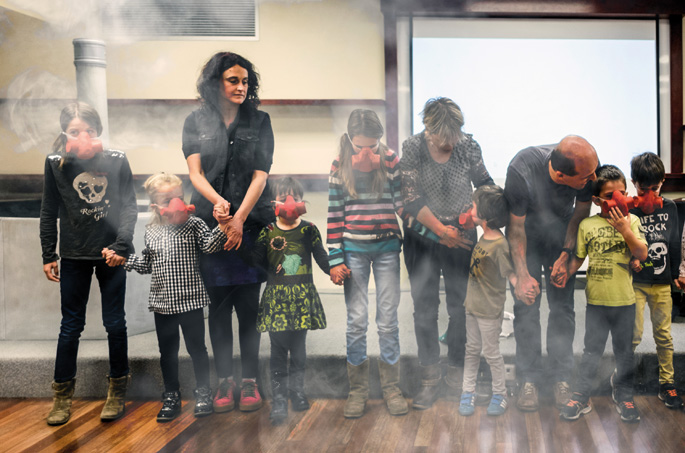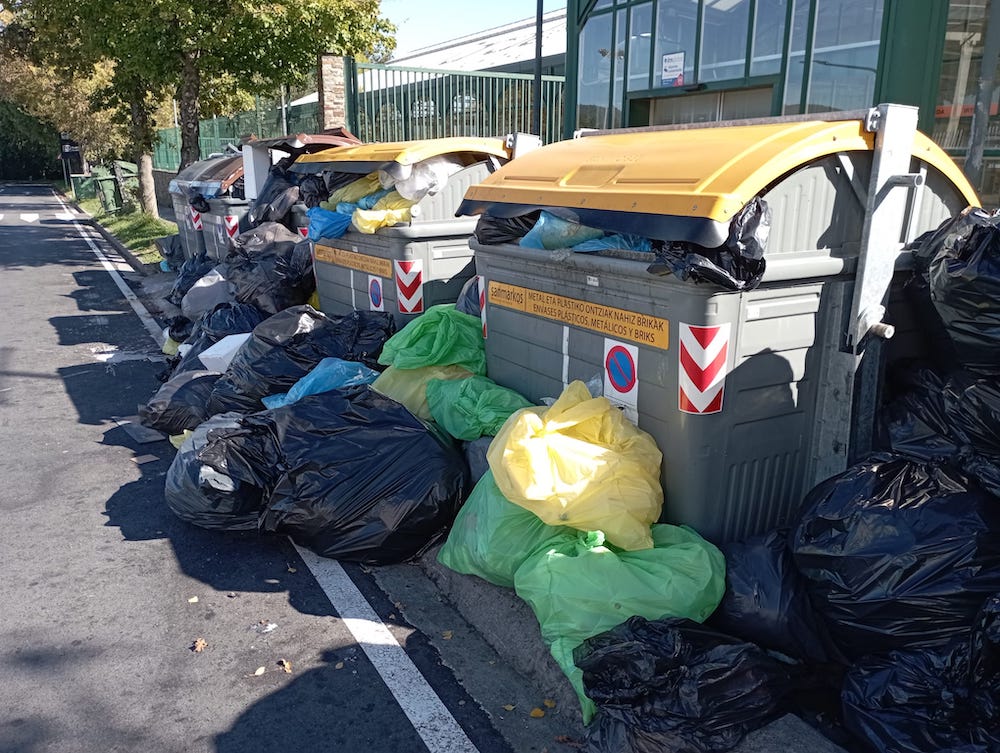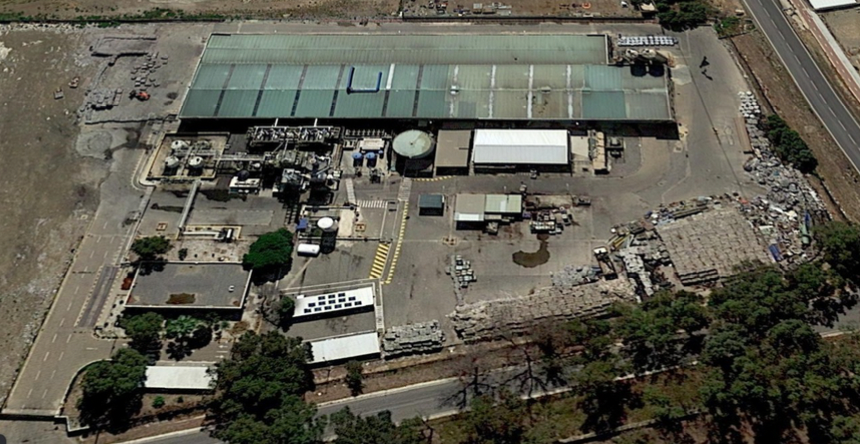The stain of the Zubieta incinerator in our health
- Residue burning is one of the most dangerous things we can do in the world. Thousands of chemicals are generated in this process, many of them very toxic to health. In order to raise awareness among Gipuzkoans of the problems that the incinerator of Zubieta will bring, on 29 May, a human health chain will be carried out from Plaza Gipuzkoa de Donostia to Onkologikoa.

Since the foral government of Markel Olano has once again demonstrated its intention to install an incinerator in Zubieta, the opposite movements have multiplied by the cost to the Gipuzkoans of the project. The Waste Consortium of Gipuzkoa recently approved the Plan: It would have an incinerator of 200,000 tonnes of waste, a centre for mechanical biological treatment and another for the recovery of slag and a bio-metering plant, which would leave waste management in private hands and impose a burden on the territory of at least EUR 1,216 million over the next twenty years.
Given the growing need to clarify data on the enormous economic cost, there has been a great deal of concern about the damage that the incinerator will cause to the health of Gipuzkoans. On 7 May, GuraSOS, the association of parents, grandmothers, grandparents and uncles concerned about the diseases that incineration can cause in children: “What I don’t want for my children, because I don’t want for others,” they explained in their manifesto.
On the other hand, the Anti-Incinerator Movement organized a human health chain on 29 May in Donostia-San Sebastián, from the Palacio de la Diputación de Gipuzkoa to Onkologikoa. The aim is to unite the five kilometres between some 5,000 people, including a bird and a flojo. Rossano Ercolini, winner of the Goldman Price International Environmental Prize and one of the leaders against incineration in Italy, has recently visited the Basque Country, and he is clear: “The lowest risk is unacceptable.” Next week in ARGIA we will offer a broad interview with Ercolini.
Together with the circular economy, the need to protect health has led to an increasingly obvious tendency in Europe to abandon incineration. One of the main battlefields is Ringaskiddy, which aims to build an incinerator near the Irish city of Cork, where University of Cork professor Gordon Reid has announced the results of a 2011 European study: According to samples from incinerators in Italy, Slovakia and England, the life expectancy of some 2.2 million people could fall by 7,600 years as a result of incineration. Among those who supported the research is the World Health Organization (WHO) itself. In the Basque Country, the Health and Incineration Research Group (OEIT) has been providing information on similar studies.
Cancers, malformations and chronic diseases
In 2002, the OEIT appeared for the first time in public, with the aim of analysing the possible consequences of the incinerator they wanted to build in Txingudi. Despite the project’s paralysis, work has continued silently, and a dozen years later the conclusion is the same: incineration is associated with cancer and increased mortality.
The results of 17 studies with proven methodological quality have been analyzed in this decade. Physicians have especially highlighted what was published in 2012 by the Epidemiology Center of the Carlos III Health Institute in Madrid: statistically, the risk of dying from cancer is higher in the population that lives less than 5 kilometers from the incinerator. Cases of pleural cancer increase by 84%, cases of gallbladder cancer increase by 24%, and leukaemias increase by 21%.
But there are more studies that confirm this connection. In a radius of 3 km of incinerators, one of them, carried out between 1983 and 2008, states that the increase in cancer can be between 3% and 50%, and another, that exposure to microparticles that leak through the filters of chimneys, increases pancreatic cancer – 40% among women and 92% among men.
As we know from dioxins, furans or heavy metals that accumulate in slag and ash, there is still a great lack of knowledge of atmospheric gases and microparticles, 60% of the mass of waste that is burned, that an incinerator throws out of the fireplace, and that affect respiratory and cardiac diseases.
The promoters of the Zubieta incinerator say that it will pour below the limits set by European legislation. However, one of the OEIT spokesmen, José Cruz Ruiz Villandiego, considers it unnecessary: “Despite the limitations, the body is very different from accepting or getting sick the doses it receives, for example, if it is an adult or a child.”
Women are particularly punished by incineration, as their body has more fat of origin and dioxins dissolve in it.
In fact, children and fetuses are the most vulnerable to incineration: endocrine and hormonal alterations, incidence in neurological development… A 2014 study highlights congenital malformations: the number of babies born with hare lip will increase by 30% and that of people with renal dysplasia by 55%.
GuraSOS has located on Google Maps the more than 200 educational centres in the 30-kilometre “area of influence” recognised by the Basque Government to the incinerator: “Doctors and scientists say there is a risk and we ask the Council of Gipuzkoa to stop the Zubieta project preventively,” said Association Member Xabier Arruti at Info7 Irratia. To this end, the collection of signatures has been initiated and information days will be held at Orona-Ideo de Hernani on 21 May. The event will be attended by Clara Perales, one of the victims who has filed a complaint against the Valdemingómez incinerator in Madrid. Perales began to suffer from respiratory and allergic problems and, after damage to the immune system, she developed breast cancer.
Two studies published in Italy in 2013 and 2015 show that contamination by incinerators is related to premature birth and miscarriage of pregnant women. Women are particularly punished by incineration, as their body has more fat of origin and dioxins dissolve in it. In addition, the mother transmits to the baby, through breast milk, toxic products stored in fats. This is the most dramatic indicator for measuring pollution, according to physiology expert Eduard Rodríguez Farré.
Rodríguez Farré has extensive experience in the field of biomedicine – his views have been expressed in programmes such as Salvados – and in December he was in Andoain talking about the toxicity of incinerators. In his opinion, the realization of epidemiological studies requires many years of work and rigor.
“A chemical bomb” next to the house
Knowing what the Catalan physiologist said, more than one was astonished at the main cover of Noticias de Gipuzkoa on March 7: “A study by Osakidetza concludes that incineration does not pose a ‘health risk’.” This report is from 2004, it has not been published in any scientific journal and the doctors of the OEIT have seen many cracks. Iñigo Suberbiola explained at the conference held by the European parliamentary group GUE/NGL on incineration in Donostia that the report makes a “dialectic trap” with conditional phrases: “if the incinerators were new”, “if they respect the law”…
The Council of Gipuzkoa has announced that it will make health surveillance of the Zubieta infrastructure available to Biodonostia. The fact that it is implicitly admitted that there can be health risks with the incinerator has provoked a great stir. Anti-incineration groups have accused foral authorities of using citizens as "guinea pigs" for testing.
“The infrastructure will have the most advanced technological and safety controls,” said MEP Markel Olano recently, when asked in the Osoigo internet service about an incinerator that has exploded in Antwerp. The video of the accident has spread to the four winds following the warning of ARGIA, which has raised concern about such a disaster in our territory.
In recent years there have been dozens of casualties. In 2013, for example, a large-scale fire invaded the Fos-su-mer incinerator in Marseille. The pollution leakage that occurs in these events is not the most despicable. The explosion of a chemical plant in the Italian locality of Seveso in 1976 caused the take-off of thousands of tons of TCDD, the most contagious dioxin possible, and subsequent studies have revealed an increase in cancer cases throughout the region.
"Incinerators are real chemical bombs," said Villandiego, not only because of what happened in Antwerp or Marseille, but also because of the permanent damage it can cause in daily life and in a very large space. At Ringaskiddy, they have recently presented the simulation of pollution that will be generated by the incinerator, with the help of the engineering team Plume Plotter, which performs this kind of work, and the toxic mist covers the whole of Cork Bay. What stain would the Zubieta fireplace generate on the map of Gipuzkoa? Do we leave our children's health to the whim of the Northwest or the currents of the valleys?
Rossano Ercolini Goldman saridunak Hernanira egindako bisitan oroitarazi zuen belaunaldi berriko erraustegi seguruenaren ikur izan zela Falascaia... eta falazia izan zela. Lucca probintziako Pietrasanta 1974an jarri zuten erraustegia –Falascaia deitua–. Herriak 1.500 biztanle ditu eta denek izan dute gertukoren bat minbiziak jota.
Mobilizazio etengabeen presiopean, urteetara onartu zuten Herriko Osasun Unitateak eta Toskanako Ingurumen Babeserako Agentziak herritarrek aspaldidanik salatzen zutena. Erraustegia itxiko zela zirudienean, hango ahaldun nagusiak, Vannino Chitik, agindu zuen zaharraren ordez berria egiteko, eremu berean. 1997an ehunka herritar erraustegiaren ateetan eseri ziren sarrera galarazteko.
Ercolinik gogoratzen ditu politikarien eta osasun publikoa babesteko erakundeen promesak: “Europako sistema kontrolatuena zela, dioxina isurketak etengabe neurtzen zituelako …”. Handik urte gutxira kudeaketa TEV Veolia multinazional frantziarraren esku geratu zen: “Bitarte horretan, gutun anonimo bat iritsi zen epaitegira –boterea galdu zuen norbaitek mendekuz bidalia, inondik ere–. Gutun horrek salatu zuen emisioak kontrolatzeko sistemari software bat jarri ziotela, kopuruak hamar aldiz gutxitzen zituena –Volkswagen autoen antzera–, emaitzak baimenaren barruan egon zitezen beti”. TEVeko arduradunek 4.000 euroko isuna baino ez zuten jaso. Herritarrentzat porrota izan zen. Baina ekarri zuen garaipenik ere: erraustegiko baimena urtebete eta erdira eten egingo zela jakinarazi zuten agintariek. Gainera, ordurako labeak itzalita zeuden: ia egunerokoak ziren herritarren mobilizazioen eraginez, erraustegia praktikan 2010ean itxi egin zen.
(Estitxu Eizagirreren Garialea blogetik ekarritako testua)
The City Hall of Donostia-San Sebastián announced at last Thursday’s plenary session that it will increase the waste rate by 26.5% from January 2025, claiming that Waste Law 7/2022 obliges this. Eguzki, for its part, has denounced that the law only applies in terms of costs,... [+]
Recently, the UPV/EHU organised a series of summer courses to address the issue of climate change. The Environment Minister, Asensio, took advantage of the courses to highlight the incinerator’s positive contribution to climate change, which is surprising, since for every tonne... [+]

























